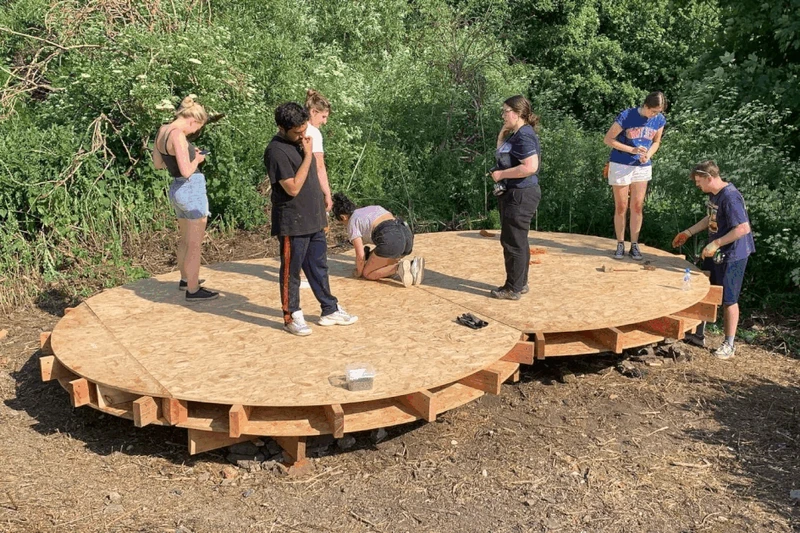Under Construction: Takeshi Hayatsu & Collaborators
14 Sep-20 Dec 2024


Launched for London Design Festival 2024
Launch Events
- Brunch Launch Event for London Design Festival: Saturday 14 September 11am-1pm
- Evening Launch Event with drinks: Wednesday 18 September 6-8pm
Under Construction is an evolving collaborative architecture project, under construction at the Stanley Picker Gallery throughout September – December 2024.
The exhibition surveys more than a decade of ambitious live-build projects led by architect Takeshi Hayatsu, working with Kingston University Architecture and Landscape students and a growing cohort of participants and community partners. Since 2011, these projects have provided imaginative and highly resourceful responses to their chosen locations in collaboration with diverse communities around Kingston, Surbiton, Tolworth and beyond.
Under Construction presents a selection of these past projects through tactile materials, highlighting different craft techniques, scale models, and re-constructed structures built for the exhibition by 121 Collective, itself formed of alumni of Hayatsu. The women’s film collective w.in.c has created a short documentary focussing on Hayatsu’s approach to teaching through making, his community centred ethos, and the haptic methodologies of the various builds, whilst the publication provides a summary of each project to date.
Throughout the exhibition an entirely new live build will take place at the Stanley Picker Gallery, developed with the 2024-25 cohort of Unit 5 MArch students from the Department of Architecture and Landscape at Kingston School of Art, Kingston University. This will include a Shrine outside the entrance and a Sauna on the Gallery’s riverside terrace, both built using a rammed-earth technique. Throughout the exhibition a series of workshops and events encourage visitors to learn about the exhibition and get involved in the live build.
Past projects such as the Bridge (2011-12), a replica of 17th century Japanese wooden Kintaikyo bridge or Woodland Chapel (2013-14), a structure made for a local St Johns Primary School both made entirely from donated and recycled materials are exemplary of the economy of means and the ethos of DIY builds. Temple (2014-15) and Seminar House Pavilion (2015-16) were created for the garden of Dorich House Museum, each championing special techniques such as elaborate carpentry or yakisugi, a Japanese method for scorching timber. The following year, the Barbican Tea House (2016-17) was a burnt timber cladded tea house specially commissioned for the exhibition ‘The Japanese House: Architecture and Lift After 1945’ at the Barbican Centre London, as a collaboration between architect Terunobu Fujimori, Takeshi Hayatsu and architecture and product design students from Kingston University.
SHEDx was a community engagement programme initiated by a community interest company The Community Brain in Kingston. Based on the notion of the university as a centre for productions and an incubator of new ideas, they built a series of sheds to establish a strong relationship between Kingston University and the local community. As part of the project The Heritage Shed (2017-18) housed a display of allotment culture. Like many other builds, this shed travelled to various contexts including the Victoria and Albert Museum, Hampton Court Flower Show and the Garden Museum. Hayatsu’s idea of democratising crafts have continued to unfold through recent collaborations such as the Green Shed (2018-19) and Nature Hide (2019-21), which involved schoolchildren decorating individual wooden panels with locally sourced clay paint, as well as public engagement elements of the Surbiton Yatai (2017-18) and the Lantern Procession (2023) launched with public processions.
Biographies & Further Information:
Takeshi Hayatsu is a Japanese architect based in London. Hayatsu studied architecture at Musashino Art University in Tokyo and Architectural Association in London. He worked for David Chipperfield Architects, Haworth Tompkins and 6a architects before establishing Hayatsu Architects in 2017. Alongside his practice he teaches MArch unit in Kingston School of Art. He also conducts annual summer school in Japan with Grizedale Arts. He is a member of Design Review Panel at Harrow Council.
Department of Architecture and Landscape, Kingston University. Architecture and Landscape are richly interconnected, and encompass aspects which are intellectual and embodied. Our situation as part of the School of Art and Architecture is key to our identity. The large workshops and the ethos of thinking through making speak of the inherent dynamic of how we see knowledge generated in the productive tension between tectonics and representation. This is a fundamental and essential part of how the department seeks to enable its students; firstly through a direct and immediate connection with how things are made and the nature of the spaces that result; and secondly with how it is represented critically.
121 Collective consists of architectural designers and makers with a special appreciation for craft, community and sustainability. After being introduced to the local community interest company The Community Brain during their time as architecture students at Kingston School of Art, they have continued to work closely together on a range of community-led projects which revolve around inclusivity and play. 121 are based at Tolworth Main Allotments at the Farm of Futures, where they have converted an abandoned shed to their headquarters, creating a sustainable community hub which supports the growth of local ideas as well as food, and promotes cross-generational skill sharing, circular economy and the upcycling of materials.
w.in.c (Women’s Independent Collective) films, was founded in 2008 by Abbe Leigh Fletcher, Petra Reynolds, Sabela Pernas Soto and Claudia Vásquez Ramírez. They are a growing network of filmmakers from the MA Filmmaking course at Kingston School of Art. Their aims are to tackle gender inequality through film and challenge established hierarchical modes of production by working collectively across continents. To make filmmaking more accessible to women and girls and to constructively celebrate international women’s perspectives through film.